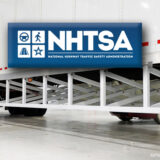U.S. DOT wants to know how to improve the supply chain
The U.S. Department of Transportation is seeking feedback on how to address challenges in the supply chain.
A notice is scheduled to publish in the Federal Register on Thursday, Sept. 16.
In February, President Joe Biden issued an executive order that requires the DOT secretary to submit a report on supply chains within one year.
“The notice requests information from the public to assist the Department of Transportation in preparing the report required by the executive order and solicits practical solutions from a broad range of stakeholders to address current and future challenges to supply chain resilience in the freight and logistics sector,” the notice states.
The DOT provided 13 topics for the public to focus on.
- The identification of major infrastructure or operational bottlenecks and chokepoints across all aspects of the freight and logistics supply chain that slow or impede efficient cargo movement within the freight and logistics sector, and the most effective investments and management practice improvements that could be made to alleviate those bottlenecks.
- Current and potential future shortages and/or distribution limitations of essential cargo-handling equipment, such as chassis and shipping containers, and how these challenges can be or are likely to be addressed by the freight and logistics industry over both the medium and longer term.
- Warehouse capacity and availability, and any challenges faced in operating and siting/constructing those facilities, as well as challenges faced by third-party logistics service providers and other stakeholders in the logistic system.
- Major risks to resilience within the freight and logistics sector. What factors help to mitigate, or conversely exacerbate, these risks?
- The effects of climate change on transportation and logistics infrastructure and its implications for supply chain resiliency.
- Technology issues, including information systems, cybersecurity risks, and interoperability, that affect the safe, efficient, and reliable movement of goods. Would greater standardization of those technologies help address those challenges?
- Key opportunities and challenges with respect to the existing and future workforce to ensure a well-functioning freight and logistics supply chain and achieve the president’s goal of increasing good-paying jobs with the choice of a union. Are there additional workforce or skill-set opportunities and needs currently, or expected in the future?
- Current barriers that inhibit supply chain performance. For any barriers identified, please address the actors involved and potential outcomes should those barriers be removed.
- Critical assets that the sector relies upon and their expected future availability. Would increasing domestic production of these assets be desirable or feasible as a means of ensuring greater supply chain resiliency?
- Technological practices, including data sharing, that are being implemented at various levels across the supply chain sector. What are the upsides, challenges, and drawbacks of further adoption?
- Actions that DOT or other agencies could take under existing authorities or in partnership with states, local governments, the private sector, or labor to address current and evolving challenges within the freight and logistics sector.
- Other policy recommendations or suggested executive, legislative, or regulatory changes to ensure a resilient supply chain that should be considered, including means to collaborate more effectively across government agencies and suggestions based on state and international models.
- Recommended actions by nonfederal entities, including state and local governments, private firms, labor, and other participants in the freight and logistics sector that could be encouraged.
How to comment
Public comments do not have to be limited to the 13 topics listed above. Once the notice is published in the Federal Register, the public will have 30 days to comment. To do so, commenters can go to the Regulations.gov website and enter Docket No. DOT-OST-2021-0106.
Driver retention
Over the summer, the Department of Transportation has been taking a look at how the industry’s inability to retain truck drivers is hurting the supply chain. Statistics show that the driver turnover rate at large fleets is consistently at 90% or more. The Owner-Operator Independent Drivers Association says the way to keep drivers in the seat is to improve compensation and working conditions. LL









